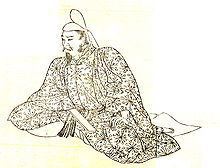Name Ono Takamura Role Scholar | Died 853 AD | |
 | ||
Ono no Takamura (小野 篁) also known as Sangi no Takamura (参議篁, 802 – February 3, 853) was an early Heian period scholar and poet.
Contents
Life
Takamura was a descendant of Ono no Imoko who served as Kenzuishi, and his father was Ono no Minemori. He was the grandfather of Ono no Michikaze, one of the three famous calligraphers (三筆, sanpitsu). In 834 he was appointed to Kintōshi, but in 838 after a quarrel with the envoy, Fujiwara no Tsunetsugu, he gave up his professional duties pretending to be ill, and attracted the ire of retired Emperor Saga, who sent him to Oki Province. Within two years he regained the graces of the court and returned to the capital where he was promoted to Sangi.
Takamura is the subject of a number of odd stories and legends. One of the most singular of these legends is the claim that every night he would climb down a well to hell and help Yama (閻魔大王, enma daiō) in his judgements (裁判, saiban). In Sataku, Kyoto, there is a grave said to belong to Takamura. Near that grave is a grave marked Murasaki Shikibu, with a legend that it was placed there by the devil himself as punishment for lust (愛欲, aiyoku) for which Murasaki Shikibu descended to hell.
Takamura in later literature
Ono no Takamura figures into several later setsuwa works such as the Ujishūi Monogatari and the Takamura Monogatari.
In Ujishūi Monogatari there is the following story about Takamura to illustrate his wit. One day in the palace of Saga Tennō, someone erected a scroll with the writing "無悪善". No one in the palace was able to decipher its meaning. The emperor then ordered Takamura to read it, and he responded "It will be good if there is no evil (悪無くば善からん, saga nakuba yokaran)," reading the character for evil (悪, aku) as "Saga" to indicate Saga Tennō. The emperor was incensed at his audacity and proclaimed that because only Takamura was able to read the scroll, he must have been the one who put it up in the first place. Takamura however pleaded his innocence, saying that he was simply deciphering the meaning of the scroll. The emperor said, "Oh, so you can decipher any writing, can you?" and asked Takamura to read a row of twelve characters for child (子): "子子子子子子子子子子子子". Takamura immediately responded: neko no ko koneko, shishi no ko kojishi (猫の子子猫、獅子の子子獅子), using the variant readings ne, ko and shi/ji for the character; this translates to "the young of cat (猫, neko), kitten (子猫, koneko), and the young of lion (獅子, shishi), cub (子獅子, kojishi)." The emperor was amused by Takamura's wit and removed the accusation.
Takamura is the main character in the tale Takamura Monogatari, in which he engages in a romantic affair with his half-sister. The work's date is heavily disputed, and few scholars take it to be historically reliable.
Descendants
While people like Ono no Michikaze are Takamura's direct descendants, he also had several spiritual descendants among the Samurai. In particular, several Samurai names such as Notarō (野太郎), Onota (小野太), Yatarō (弥太郎), Koyata (小弥太) can be traced to Takamura.
Representative poems
One of his poems is included as No. 11 in Fujiwara no Teika's Ogura Hyakunin Isshu:
Takamura contributed six poems to the Kokin Wakashū: #335, 407, 829, 845, 936, and 961.
